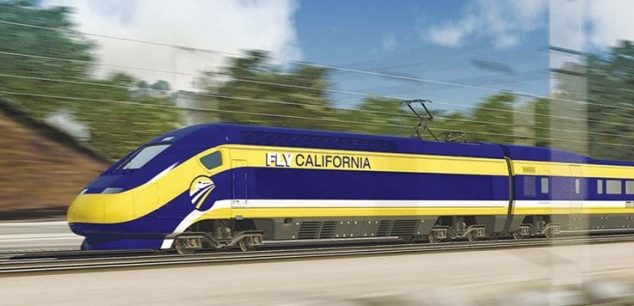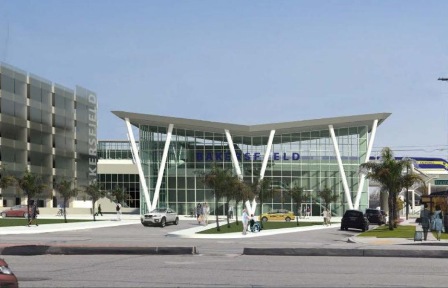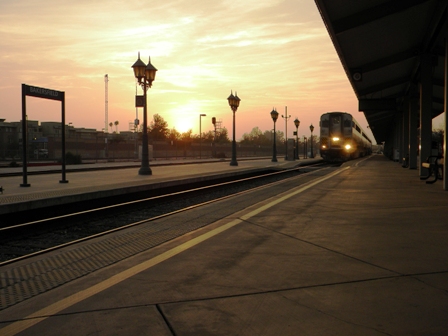News
Bakersfield focus in bullet train battle
 An artist's rendition of the California bullet train. (Illustration: California High Speed Rail Authority)
An artist's rendition of the California bullet train. (Illustration: California High Speed Rail Authority)At the heart of the dispute over California’s bullet train project is Bakersfield, where a legal battle has sent ripples through the multibillion-dollar system.
“We have adversely affected all of Southern California,” said Adam Cohen, a Bakersfield transportation and planning consultant who closely monitors the high-speed train’s path and station through his city.

An artist’s illustration of the Truxton Ave. station.
The core issue is where the track will go from Poplar Avenue north of Shafter to one of two proposed locations in Bakersfield – to the original Truxtun Avenue station, also served now by Amtrak, or to a new location on F Street. The issue remains under review because of lawsuits by local governments three years ago.
Early on, the location of the Bakersfield bullet-train station appeared settled. In 2003, the Bakersfield City Council adopted a resolution supporting the Truxton Avenue site.
But legal challenges intervened and last month, the High Speed Rail Authority released a draft report that examines a second site in Bakersfield for a high-speed rail station and the document is open for comments from the public. The second location, on F Street, is now being studied.
While the city strongly supports the new station in the Authority’s environmental impact report, not all of its citizens do.
And that’s the problem.
Cohen, a research associate with UC Berkley’s Transportation Sustainability Research Center, said his comments don’t reflect the views of the university or his clients.
But he said Bakersfield’s lawsuit has cost the $68 billion HSR project millions of dollars and delayed it by four years.
Troy Hightower, a retired regional planner for Kern County’s Council of Governments, has been involved with the HSR project in Bakersfield for about 12 years. He agrees with Cohen.
The council, known as KernCOG, is an association of city and county governments that targets regional transportation issues.

An artist’s illustration of the F Street station.
“Originally the state was going to go south, but because of all the problems the city has caused, now they’re going north,” Hightower said.
High speed rail construction is well under way in Fresno and Madera, where there are 18 active construction sites.
The High Speed Rail Authority has signed three design-build contracts totaling 119 miles. These contracts cover the area from the City of Madera to Poplar Ave.
The HSR Board certified a final EIR for the Fresno to Bakersfield segment in March 2014, but Bakersfield, Shafter, Kern County and Dignity Health filed related suits against the Authority under CEQA, or the California Environmental Quality Act.
Bakersfield City Manager Alan Tandy said the Authority’s approved EIR would have taken out the city’s corporation yard and police vehicle maintenance facility. It would also eliminate all the parking spaces for one of the city’s proudest accomplishments, the Rabobank Arena Theater and Convention Center, and affect an area the city recently rehabilitated.
“They [the Authority] had been meeting with us for two years and essentially they ignored everything we had suggested to them,” Tandy said in an email.
But if the city of Bakersfield hadn’t sued the Authority, would there be construction in the city now?
“No I do not think there would have been construction,” Tandy said, “the money they have runs out when they get to Wasco – the technical ability to build here would not have changed that in my view.”
HSR spokeswoman Lisa Marie Alley agrees, saying the decision to end at Shafter was based on funding and getting a test track up and running.
And Alley said the draft supplemental EIR is part of the “evolution” of high speed rail.

An Amtrak train pulls into the existing Truxton station. (Photo: Dorothy Mills-Gregg)
“This is the evolution about how to get into Bakersfield,” she said after mentioning the long environmental review process they have to undergo to clear the high speed rail’s path.
Though she did acknowledge delays have caused the high speed rail project costs to increase.
“The costs are not going up because of lawyers,” Alley said, “but because of a handful of opponents delaying projects.”
Delay tactic is one of a couple theories as to why the city wants the station in a different location, Hightower said.
Any effort “to delay the project could cause the project more risk and ultimately cause it to fail,” he said.
Others believe the cash-strapped city wants to improve Route 204, the highway that intersects the city’s preferred station site. Placing the high-speed rail station there, they argue, would attract the funds the city needs.
But Hightower contends the city is not being transparent and straight-forward with its residents, an argument the city has rejected. “The city’s been telling everybody that the decision’s been made,” Hightower said.
Tandy rejected Highhtower’s position, saying there has been ample “study, public review and public participation to consider our alignment…It’s disingenuous at best for him to say there has not been transparency.”
But even then, the bureaucratic hurdles are not over: The new alignment must be approved by the Federal Railroad Administration and the Surface Transportation Board.
Meanwhile, the Bakersfield City Council declared its support for the draft supplemental EIR in a resolution it unanimously passed six days before the state held the public hearing to accept comments.
The state’s decision is expected in 2018 and will release the decision — Truxtun Avenue or F Street?
As for the bullet train, it wants a station in Bakersfield, one way or another.
“The high speed rail is committed to getting into Bakersfield,” Alley said, “and to provide for the citizens of Bakersfield to get to those other parts of the state.”
—
Ed’s Note: This is the first of two parts on California’s bullet train project.
Want to see more stories like this? Sign up for The Roundup, the free daily newsletter about California politics from the editors of Capitol Weekly. Stay up to date on the news you need to know.
Sign up below, then look for a confirmation email in your inbox.

great article summarizing the problem.
Who made the decision for the rail? The government or the people?
With any and all due respect, what difference does it make? Once “…the people…”, by way of the political system (as opposed to a market system), make ANY decision to turn anyTHING over to government, the decisions as to how (and to the benefit of whom) that decision if implemented and ultimately manifested is up to the government, not “…the people…” who voted for the project. That’s not to say that the private sector doesn’t also have its share of boondoggle projects but at least in the private sector, you have the choice of not continuing (or even starting in the first place) to spend your money on the boondoggle should it not be in your own best interest to do so.